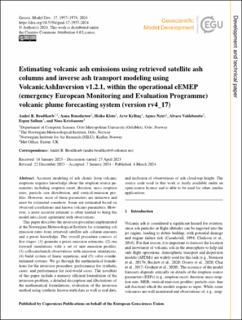| dc.contributor.author | Brodtkorb, André R. | |
| dc.contributor.author | Benedictow, Anna Maria Katarina | |
| dc.contributor.author | Klein, Heiko | |
| dc.contributor.author | Kylling, Arve | |
| dc.contributor.author | Nyiri, Agnes | |
| dc.contributor.author | Valdebenito Bustamante, Alvaro Moises | |
| dc.contributor.author | Sollum, Espen | |
| dc.contributor.author | Kristiansen, Nina Iren | |
| dc.date.accessioned | 2024-03-21T06:50:20Z | |
| dc.date.available | 2024-03-21T06:50:20Z | |
| dc.date.created | 2024-01-31T21:45:15Z | |
| dc.date.issued | 2024 | |
| dc.identifier.citation | Geoscientific Model Development. 2024, 17 1957-1974. | en_US |
| dc.identifier.issn | 1991-959X | |
| dc.identifier.uri | https://hdl.handle.net/11250/3123497 | |
| dc.description.abstract | Accurate modeling of ash clouds from volcanic eruptions requires knowledge about the eruption source parameters including eruption onset, duration, mass eruption rates, particle size distribution, and vertical-emission profiles. However, most of these parameters are unknown and must be estimated somehow. Some are estimated based on observed correlations and known volcano parameters. However, a more accurate estimate is often needed to bring the model into closer agreement with observations. This paper describes the inversion procedure implemented at the Norwegian Meteorological Institute for estimating ash emission rates from retrieved satellite ash column amounts and a priori knowledge. The overall procedure consists of five stages: (1) generate a priori emission estimates, (2) run forward simulations with a set of unit emission profiles, (3) collocate/match observations with emission simulations, (4) build system of linear equations, and (5) solve overdetermined systems. We go through the mathematical foundations for the inversion procedure, performance for synthetic cases, and performance for real-world cases. The novelties of this paper include a memory efficient formulation of the inversion problem, a detailed description and illustrations of the mathematical formulations, evaluation of the inversion method using synthetic known-truth data as well as real data, and inclusion of observations of ash cloud-top height. The source code used in this work is freely available under an open-source license and is able to be used for other similar applications. | en_US |
| dc.language.iso | eng | en_US |
| dc.rights | Navngivelse 4.0 Internasjonal | * |
| dc.rights.uri | http://creativecommons.org/licenses/by/4.0/deed.no | * |
| dc.title | Estimating volcanic ash emissions using retrieved satellite ash columns and inverse ash transport modelling using VolcanicAshInversion v1.2.1, within the operational eEMEP volcanic plume forecasting system (version rv4_17) | en_US |
| dc.type | Peer reviewed | en_US |
| dc.type | Journal article | en_US |
| dc.description.version | publishedVersion | en_US |
| cristin.ispublished | true | |
| cristin.fulltext | original | |
| cristin.fulltext | original | |
| cristin.qualitycode | 2 | |
| dc.identifier.doi | 10.5194/gmd-17-1957-2024 | |
| dc.identifier.cristin | 2241259 | |
| dc.source.journal | Geoscientific Model Development | en_US |
| dc.source.volume | 17 | en_US |
| dc.source.pagenumber | 1957-1974 | en_US |
| dc.relation.project | Norsk romsenter: NIT.09.16.05 | en_US |
| dc.relation.project | NILU: 116091 | en_US |
| dc.relation.project | Meteorologisk institutt: 185050 | en_US |
| dc.relation.project | Avinor: 23000105 (Askevarsling) | en_US |

